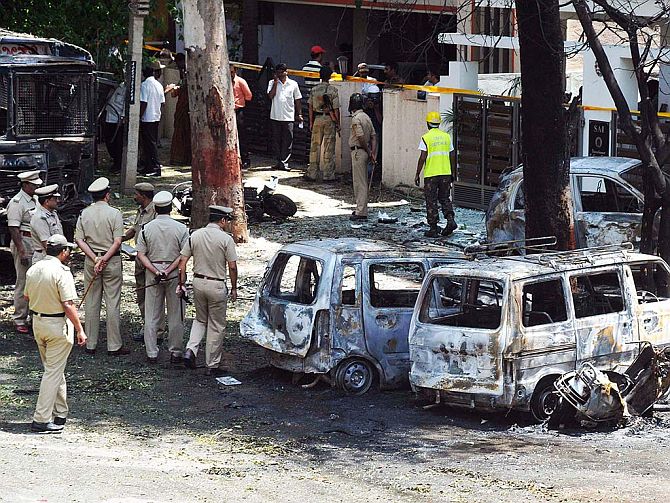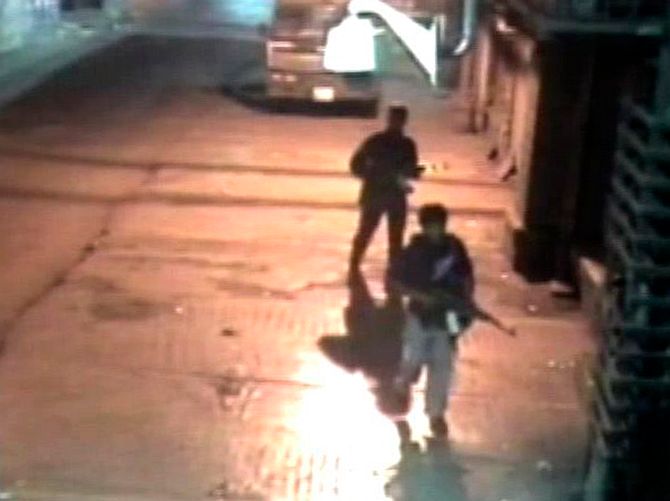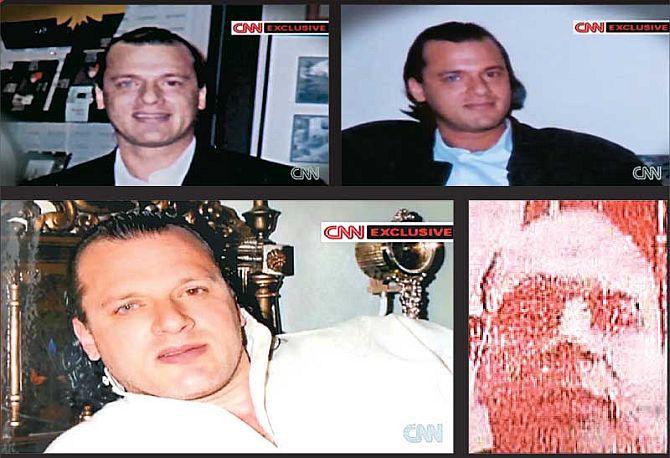
On the fifth anniversary of the gruesome November 26, 2008 attacks on Mumbai Rediff.com's Vicky Nanjappa examines the threat perception to India, its preparedness and the conspiracy theories surrounding 26/11.
How strong is the Lashkar-e-Tayiba today? An intelligence report about the LeT -- post the November 26, 2008 attacks that claimed 166 lives -- raising 150 million pounds from the United Kingdom alone and spending just 30 million pounds for charity while using the rest of the funds for terror, gives a relatively clear picture.
The Lashkar's fundraising from the UK is just second to what it raises from the Middle East. Relying heavily on Muslims in the UK and the deep-rooted crime syndicate set up by fugitive gangster Dawood Ibrahim, the Lashkar has it easy while raising funds from the UK.
The report states the first traces of the Lashkar in the UK were seen in 2005 when its founder Mohammad Saeed visited London and gave a lecture that was attended by over 10,000 people.
Word about this speech spread far and wide and before anyone could realise the outfit had recruited over 80 Pakistanis holding a British passport to wage jihad. Most of them were sent to Afghanistan for training and later told to return to the UK and await orders.
An Intelligence Bureau official tracking the LeT's UK connection tells Rediff.com that Saeed's speech focused more on the protection of Muslims worldwide and also the need to contribute towards the Jamaat-ud-Dawa, the LeT's so-called charity wing.
Funds have never been a concern for the Lashkar. It spends lavishly and rewards successful operatives up to Rs 20 lakh (rs 2 million).
For the 26/11 attack, estimates reveal that the Lashkar spent over Rs 10 crore (Rs 100 million).
Kindly ...

Besides donations, the Lashkar enjoys a steady flow of cash through the crime syndicates.
Dawood Ibrahim, reportedly, contributes 40 per cent of his earnings to Pakistan's Inter Services Intelligence directorate in exchange for protection and a comfortable lifestyle in Karachi. He has also created a perfect liaison between his associates and the Lashkar in the UK, Australia, Thailand, Africa and, of course, India.
Post 26/11, the Lashkar command structure has not changed. Mohammad Saeed roams around scot-free, often addressing his followers.
Lashkar commander Zaki-ur-Rehman Lakhwi may be in jail, but continues to be the operational head. He has an office in prison from where he continues to operate.
There are also the likes of Professor Abdul Rehman Maki who spread the Lashkar's message convincingly. Zarar Shah and Usuf Muzzamil, who were part of the 26/11 attacks, enjoy a great deal of protection.
The Lashkar, in fact, has become bigger today says an Intelligence Bureau official. It even funds Al Qaeda and five other outfits, including the Indian Mujahideen in India to the tune of Rs 70 million.
The Harkat-ul-Mujahideen, the Harkat-ul-Jihadi-Islami, Babbar Khalsa International and the Jaish-e-Mohammad are other outfits operating on Lashkar funds.
Kindly ...

Five years ago, intelligence agencies failed to prevent 26/11. Five years on, the intelligence apparatus has still not really been worked out.
Multiple agencies in New Delhi have had over 1,500 meetings post 26/11.
While there have been many discussions on sharing intelligence, the one aspect that none have been able to sort out is coordination between the central and state intelligence and law enforcement agencies.
This has led to an unstoppable spate of attacks by home-grown terrorist outfits.
While the Research and Analysis Wing and the Intelligence Bureau have been handling cross-border attacks, home-grown terrorism in the form of the Indian Mujahideen has been a cause of concern.
There have been nearly 15 attacks since 26/11, all of which have been carried out by home-grown outfits. The lack of coordination between the state and central agencies is squarely to blame for this.
The National Investigation Agency, which was set up after the 26/11 fiasco, has often complained that state units do not cooperate with it.
The NIA, which takes over all terrorism cases, waits for over 15 days after an attack for a home ministry order to handle the case. Then the agency comes across half-baked information on hand since local officers put their egoes before the national interest, an NIA officer told Rediff.com
Kindly ...

Coastal security is probably one aspect that has seen improvements since 26/11. But concerns remain.
There are limitations in this aspect, but we are in a much better position compared to five years ago, a naval officer told Rediff.com.
To prevent sea-borne attacks, the central and state governments had decided to set up a force comprising fishermen who could pass on information.
Coastal police stations were set up and fishermen were handed mobile phones to pass on information. This exercise has not gone as per plan and many fishermen have complained about the lack of proper incentives and have very often done a half-baked job.
The coastal police stations in many places wear a deserted look.
Some police officers find their job boring, as they are isolated from the rest of the world.
Moreover, police chiefs have not put their best men on the job and a posting at the coastal police station has very often been a punishment transfer.
Even in Mumbai, loopholes in coastal security persist. There have been four instances where there has been lack of communication at the ports. Fortunately, none of the intrusions were lethal in nature and they were just boats which had gone astray.
The other major issue is the free for all entry and exit point at the Gateway of India. Post 26/11, it was decided that there would be a common entry and exit point at this area so that manning the yachts and boats would be easier. However, this continues to remain a concern and none of the officers that Rediff.com spoke to were able to provide answers for the same barring the fact that they were still looking into the issue.
Kindly ...

Was there local support for David Coleman Headley? Was selective information sharing by the United States the reason why India bled on 26/11?
Conspiracy theories are abundant. Indian agencies have in the past rubbished claims of local help for Headley.
But, the more one looks at the case it becomes evident that the police did not want to probe the local angle at all.
An evidence of the police's sloppy job were the arrests of Fahim Ansari and Sabahuddin Ahmed for being the local support in the 26/11 attacks. But Headley never mentioned them and neither did Ajmal Kasab, the lone terrorist who was captured. The theory was struck down thrice and the duo were acquitted.
An IB officer says that unlike Headley, the 10 terrorists did not have the benefit of strolling around the city before carrying out the attacks. Investigations show they came in and immediately went about the attacks with a great deal of precision.
Kasab maintained they had studied the targets using maps. This is too good to be true, says an officer who believes that there was more than one local accomplice who helped set up the attacks.
Eyewitness accounts, which were initially recorded but never made it to the chargesheet, suggest that Kasab was guided by a man during the initial part of the attack. This man acted as a guide during the beginning of the attack and could have well escaped or left the country.
The other aspect that the Mumbai Crime Branch did not probe or add to the chargesheet was regarding the Global Positioning System recovered from the dinghy used by the terrorists. This GPS had a red spot marked for Uran, which suggested the terrorists were planning to make a stopover before entering the city.
Kindly ...

There has been debate on the intelligence the US Central Investigation Agency shared with R&AW on the 26/11 attacks.
After the Headley episode came to light, there were calls and meetings in which R&AW agents accused the CIA of passing on selective intelligence.
An officer who was involved in these deliberations told Rediff.com that the selective intelligence sharing was part of the CIA's larger strategy.
It was not the embarrassment of their agent turning rogue that kept the US mum on Headley, but the fact that he was the man that could lead them to Osama bin Laden.
The manner in which Headley was handled after his arrest is a clear indicator of the protection he received from the US.
An NIA officer, who was part of the Headley investigation, says he sang like a parrot what the Americans had taught him.
"There was not an iota of information that we got from him barring what he had already told the FBI (Federal Bureau of Investigation). Moreover, the questioning was under the watchful eyes of the FBI at all times," this NIA officer said.
Further proof of Headley's protection can be seen in the failure of Operation Morocco.
Headley's former wife, Faiza Outalha who was with him at all times in the run-up to 26/11 had agreed in principle to cooperate with India. Based in Morocco, R&AW launched an operation to question her. However, she backed out at the last minute, probably succumbing to US pressure, the NIA officer points out.